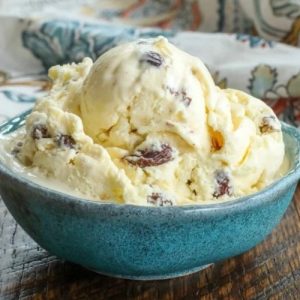Indulge in the rich, creamy delight of Rum Raisin Ice Cream, where plump rum-soaked raisins mingle with a velvety custard base.
High in protein from the egg yolks and packed with the natural sweetness of raisins, this dessert offers satisfying flavors with wholesome benefits.
Perfect for a weekend treat or easy homemade dessert, it’s both elegant and approachable.

Homemade Rum Raisin Ice Cream
Equipment
- 1 small jar (for soaking raisins)
- 1 medium saucepan
- 1 Medium Mixing Bowl
- 1 large mixing bowl (for ice bath)
- 1 smaller metal bowl (fits inside large bowl)
- (1) Whisk
- 1 heatproof spatula
- 1 Fine-mesh sieve
- 1 Ice Cream Maker
- 1 Airtight container (for storage)
Ingredients
Rum-Soaked Raisins
- ½ cup raisins
- ¼ cup Caribbean rum
Ice Cream Base
- 2 cups heavy cream
- 1 cup whole milk
- ½ cup granulated sugar
- ¼ teaspoon kosher salt
- 5 large egg yolks
- 2 tablespoons Caribbean rum
- ¼ teaspoon ground nutmeg
- 1 batch Rum-Soaked Raisins from above
Instructions
- Soak the Raisins in Rum: Begin by preparing the rum-soaked raisins, which are the star of this ice cream. Place ½ cup of plump raisins into a small jar or airtight container. Pour ¼ cup of Caribbean rum over the raisins, ensuring they are completely submerged. Secure the lid and gently shake the jar to combine the raisins and rum. Let them soak for at least 4 hours, or ideally overnight, until the raisins have absorbed the rum and expanded in size. This step infuses deep flavor and a subtle boozy warmth into your ice cream.
- Set Up an Ice Bath: Before you start cooking the custard, prepare an ice bath for rapid cooling. Fill a large mixing bowl with ice and add enough cold water so the ice can float freely. Place a smaller metal bowl inside the ice bath. This setup will help you cool the custard quickly once it’s cooked, which stops the cooking process immediately and prevents curdling. Quick cooling also preserves the creamy texture and keeps your ice cream safe to eat.
- Warm the Cream Mixture: In a medium saucepan, combine 2 cups of heavy cream, 1 cup of whole milk, ½ cup sugar, and ¼ teaspoon kosher salt. Place the saucepan over medium-high heat and stir gently as it warms. Continue heating for approximately 5 minutes, or until you see steam rising from the surface—but avoid letting it boil. This gentle warming prepares the cream to temper the eggs without scrambling them.
- Whisk the Egg Yolks: While the cream mixture is heating, separate 5 large eggs and place the yolks in a medium mixing bowl. Whisk the yolks until they are smooth and slightly pale. This step ensures even incorporation with the hot cream and prevents lumps in the custard.
- Temper the Eggs with Warm Cream: To avoid curdling, slowly pour about one cup of the heated cream mixture into the egg yolks while whisking vigorously. Continue gradually adding the remaining half of the cream mixture while maintaining a steady whisk. This process brings the eggs up to temperature gently, creating a silky base for the custard without scrambling the yolks.
- Cook the Custard to Thicken: Transfer the tempered egg mixture back into the saucepan. Cook over medium heat, stirring continuously with a heatproof spatula. Scrape the bottom and sides of the pan as you stir to prevent sticking or burning. The custard is ready when it thickens enough to coat the back of the spatula, approximately 5–6 minutes. This slow cooking develops a rich, creamy texture and enhances the flavor of the ice cream.
- Strain the Custard for Smoothness: Immediately remove the custard from heat and pour it through a fine-mesh sieve into the smaller metal bowl in your prepared ice bath. Straining removes any cooked egg bits, ensuring a perfectly smooth ice cream base. Stir the custard gently in the ice bath to accelerate cooling until it reaches room temperature.
- Add Flavorings: Once cooled, stir in 2 tablespoons of Caribbean rum and ¼ teaspoon of ground nutmeg.The rum adds warmth and depth, while the nutmeg gives a subtle spice that complements the sweet raisins. Mix thoroughly to evenly distribute the flavors.
- Chill the Custard Thoroughly: Cover the bowl with plastic wrap and place it in the refrigerator for at least 4 hours, or overnight. Chilling not only allows flavors to meld but also improves the texture when churning, making the ice cream smooth and scoopable.
- Churn the Ice Cream: Once the custard is fully chilled, pour it into your ice cream maker. Follow the manufacturer’s instructions for churning. This process incorporates air, creating a light and creamy consistency while freezing the custard gradually for optimal texture.
- Fold in Rum-Soaked Raisins: After churning, transfer the ice cream into an airtight container. Gently fold in the rum-soaked raisins along with any remaining rum from the soaking jar. This step ensures every bite has plump, flavorful raisins distributed throughout.
- Freeze for Firmness or Serve: You can serve the ice cream immediately for a soft, creamy texture, or place it in the freezer for 2–3 hours to achieve a firmer, scoopable consistency. Store any leftovers in the airtight container for up to a week, enjoying a decadent homemade treat whenever desired.
Notes
- Always use high-quality Caribbean rum for soaking the raisins and adding to the custard, as it imparts a rich, authentic flavor that defines the dessert.
- Soaking the raisins for several hours or overnight ensures they plump up and absorb enough rum to remain moist and flavorful in the frozen ice cream.
- Make sure the custard cools quickly in an ice bath before refrigerating. Rapid cooling prevents overcooking, preserves the creamy texture, and minimizes food safety risks.
- When churning, follow the ice cream maker’s instructions carefully. Over-churning can make the ice cream overly dense, while under-churning may leave it too soft.
- Allow the ice cream to firm up in the freezer for a couple of hours if you prefer a scoopable consistency that holds its shape well.
Chef’s Secrets for Perfect Ice Cream
Creating a perfectly creamy custard-based ice cream takes a few mindful techniques.
First, tempering the eggs is essential: adding warm cream slowly to the yolks while whisking prevents scrambling and ensures a smooth texture.
Gentle, continuous stirring during cooking develops the custard’s thickness without curdling.
Another secret is balancing flavors—adding nutmeg gives a subtle warmth, while rum provides depth. For extra richness, experiment with a touch of vanilla extract or a pinch of cinnamon.
Finally, always fold in the rum-soaked raisins at the end; this preserves their plumpness and prevents them from sinking to the bottom.
Serving Suggestions for Elegant Presentation
Rum Raisin Ice Cream shines on its own, but you can elevate it with thoughtful pairings.
Serve in chilled bowls or waffle cones for a classic presentation, or layer it with chocolate sauce, caramel drizzle, or crushed biscotti for a more decadent experience.
Garnish with a few whole rum-soaked raisins or a light sprinkle of nutmeg for visual appeal.
This ice cream also pairs beautifully with warm desserts like apple pie or chocolate brownies, offering a contrast between creamy cold and warm textures.
Storage Tips for Longevity
Store Rum Raisin Ice Cream in an airtight container to prevent freezer burn and preserve flavor.
For best texture, press a piece of plastic wrap directly onto the ice cream surface before sealing.
Keep it in the coldest part of your freezer rather than the door, where temperature fluctuations can soften it.
Homemade ice cream is best enjoyed within 1–2 weeks, as prolonged storage may affect the creamy texture and intensity of the rum flavor.
Always allow slightly softened scoops for the best serving experience.
Frequently Asked Questions
1. Can I make this without alcohol?
Yes! You can replace the rum with orange juice, apple cider, or a simple sugar syrup.
While the flavor will be slightly different, the raisins will still plump and sweeten the ice cream nicely.
2. How long should I soak the raisins?
For the best results, soak raisins at least 4 hours. Overnight soaking is ideal for maximum flavor infusion and plumpness.
The longer they soak, the juicier and more flavorful they become.
3. Can I use a different type of milk or cream?
Whole milk and heavy cream provide the classic creamy texture.
You can substitute with half-and-half or plant-based alternatives, but note that the ice cream may be slightly less rich and thick.
4. Why is an ice bath necessary?
The ice bath quickly cools the custard, stopping the cooking process to prevent overcooking and curdling.
It also helps maintain a smooth, silky texture and ensures the ice cream freezes evenly when churned.
5. Can I prepare this in advance for a party?
Absolutely! You can make the custard and soak the raisins a day ahead, refrigerate overnight, and churn on the day of serving.
The ice cream can also be fully prepared and stored in the freezer up to a week in advance, making it perfect for entertaining.

